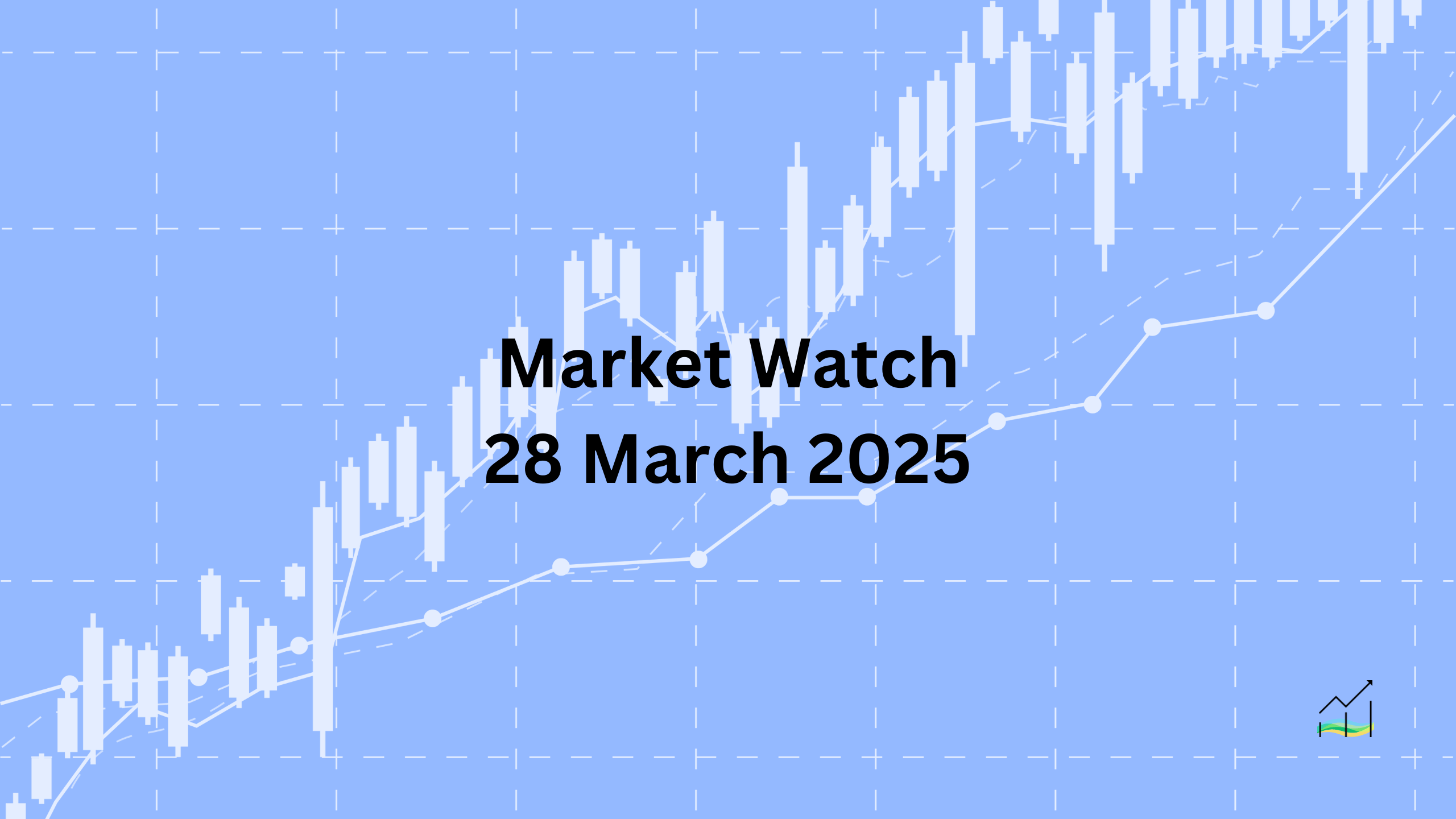28/03/2025 Market Watch

Gold Surges, Tariffs & Tokyo CPI Surprise
The U.S. dollar recovered today after a weak session, gaining against most major currencies except the Japanese yen. Currency markets responded to shifts in yields, UK economic surprises, and a softer euro. Meanwhile, equity markets came under pressure from U.S. auto tariffs, and bond markets rallied as investors moved to safer assets. Commodities also saw strong moves, with gold reaching record highs and oil extending its weekly gains.
The yen held firm despite higher-than-expected inflation in Tokyo, supported by a dip in U.S. 10-year yields—down about seven basis points from recent highs. This yield pullback provided some relief to the yen without shifting expectations for the Bank of Japan.
In the UK, stronger-than-expected retail sales and the first trade surplus in nearly four years (excluding precious metals) gave sterling a lift. However, central European currencies slipped as euro weakness dragged the region’s sentiment lower.
U.S. tariffs on autos this week—and more expected next week—rattled equity markets globally. Tokyo and Taiwan saw losses of over 1%, while only Australia managed to close higher among major indices. In Europe, the Stoxx 600 fell for the third straight day and has now declined in six of the last seven sessions. U.S. index futures also pointed lower.
Bond yields dropped across the board. European 10-year yields fell by about four basis points, while UK 10-year Gilts dropped more than five, even with upbeat retail figures. The bond rally reflects a cautious shift in sentiment.
Gold extended yesterday’s 1.25% surge, hitting a new record near $3,086, well above last week’s $3,022 close. Oil prices also strengthened, with May WTI near $70—up nearly 2.6% for the week and on track for a third consecutive weekly gain.
United States of America
Overview
The U.S. dollar is trading in a narrow range as markets digest the latest auto tariffs, inflation data, and evolving expectations for Federal Reserve policy. Despite initial volatility, the Dollar Index (DXY) remains technically constructive, supported by improving short-term momentum. Broader market focus is shifting toward the longer-term impact of trade measures and inflation trends, rather than today's scheduled data releases.
Economic Drivers
Market sentiment is being shaped more by macroeconomic context than individual data points. Key drivers include ongoing tariff risks, Fed policy outlook, and recent shifts in growth and spending expectations.
- The U.S. auto tariffs and rising geopolitical tensions have added uncertainty to the inflation outlook.
- While inflation remains elevated, current data suggests manageable increases rather than renewed acceleration.
- The Federal Reserve is still expected to cut rates this year, though expectations have slightly moderated—from 70 basis points last week to nearly 65 basis points now.
- Despite a likely rebound in personal spending, growth expectations remain muted.
- The Atlanta Fed’s GDPNow model forecasts a 1.8% contraction for Q1 2025, though an alternative model—adjusted for gold trade—shows a slight 0.2% expansion.
Data and Events
Today’s scheduled releases are unlikely to cause major market shifts but still provide insight into current economic conditions.
- PCE Deflator (February) – The Federal Reserve’s preferred inflation gauge is expected to rise by 0.3% in both headline and core measures. Annual headline inflation is forecast to remain at 2.5%, while core inflation may rise to 2.7% from 2.6%.
- Personal Spending (February) – After a 0.2% decline in January, spending is projected to rebound with a 0.5% increase.
- University of Michigan Consumer Sentiment (Final March Reading) – Unlikely to shift market sentiment, as confidence has already been weighed down by persistent inflation expectations.
Price Action
Technically, the Dollar Index is showing a constructive pattern. It has held above the 104.00 support level after testing it successfully and is consolidating just above 104.20. Notably, the 5-day moving average is crossing above the 20-day moving average for the first time in two months—indicating strengthening short-term momentum. Despite failing to break Wednesday’s high near 104.70, the setup suggests underlying support for the dollar.
Key Points:
- The dollar remains supported above key technical levels, with moving averages turning positive.
- Auto tariffs and inflation expectations are now bigger drivers than today's economic data.
- The PCE deflator is expected to confirm manageable inflation, not prompt surprises.
- Fed rate cut expectations remain, but have slightly moderated this week.
- Personal spending is rebounding, but GDP growth projections are still soft.
- Market sentiment is shifting toward longer-term implications of trade policy and inflation trends.
Australia
Overview
The Australian dollar has been trading in a tight range amid market uncertainty, showing limited movement over the past three sessions. While price action remains contained, attention is building ahead of a busy economic calendar and the upcoming central bank meeting. Political developments and future rate expectations are also beginning to shape sentiment, adding to the cautious tone in the market.
Economic Drivers
Fundamental influences on the Australian dollar remain limited for now, but several broader developments are beginning to gain relevance, particularly around fiscal policy and forward rate expectations.
- Recent fiscal support measures were announced ahead of the newly scheduled national election on May 3.
- While no immediate policy changes are expected at the next central bank meeting, forward guidance will be closely watched.
- Futures markets are pricing in nearly a 70% chance of a rate cut at the May 20 meeting, suggesting growing dovish expectations.
Data and Events
A series of domestic economic releases next week could drive short-term direction, although the central bank meeting remains the main focus.
- February Retail Sales – Will offer insights into consumer demand and resilience.
- Trade Balance – Important for gauging external sector strength and export dynamics.
- Household Spending – Another key indicator of internal economic momentum.
- RBA Policy Meeting (April 1) – No policy change is expected, but guidance will be scrutinized for rate cut signals.
Price Action
The Australian dollar has been consolidating in a narrow band between $0.6280 and $0.6330, with the broader technical range defined at $0.6265–$0.6345. The pair remains within this zone today, and only a breakout beyond these levels would carry technical significance. Momentum indicators are currently neutral, offering no strong directional bias.
Key Points:
- AUD remains confined within a narrow trading range, awaiting clearer direction.
- Momentum is neutral; price remains technically rangebound unless a breakout occurs.
- Key data next week includes retail sales, trade figures, and household spending.
- RBA is not expected to act on April 1, but forward guidance could influence market sentiment.
- Futures markets are leaning toward a rate cut by May 20.
- Political and fiscal developments are beginning to shape the broader outlook.
Canada
Overview
The Canadian dollar continues to weaken against the U.S. dollar, as trade-related uncertainty dominates market sentiment. Despite a modest rebound in Canada’s January GDP, the broader narrative is being shaped by the risk of further U.S. tariffs and shifting market dynamics. Recent price action in USD/CAD reflects a potential shift toward higher levels, with technical resistance levels now in focus.
Economic Drivers
While Canada's economic performance is showing signs of improvement, broader macro influences—especially from the U.S.—are playing a more dominant role in driving the currency.
- The looming risk of additional U.S. tariffs is weighing on sentiment toward the Canadian dollar.
- Domestic economic data, while strong in isolation, may be overshadowed by external trade policy developments.
- Market participants are likely to discount near-term growth figures if geopolitical and trade risks persist.
Data and Events
Canada released its January GDP figures today, which offered a snapshot of economic momentum at the start of the year.
- January GDP – Expected to show 0.3% growth, which would mark the strongest monthly gain since April of last year.
- U.S. Auto Tariff Announcements – Recent tariff actions are seen as more impactful for short-term trading decisions than domestic data.
Price Action
USD/CAD made a fresh monthly low near 1.4235 on Wednesday before rebounding sharply. The rally extended to 1.4330, possibly influenced by $400 million in options that expired at the 1.4300 level. Today, the pair has touched a new three-day high. A move above the 1.4350–1.4360 resistance zone could open the door to a recovery toward 1.4550, the monthly high, with intermediate resistance levels seen near 1.4400 and 1.4450. The momentum favors continued upside as long as these technical thresholds are tested and breached.
Key Points:
- Canadian dollar under pressure despite upbeat GDP expectations.
- U.S. tariff concerns are having a greater impact than local economic data.
- January GDP is expected to post a 0.3% gain, matching the best monthly pace since last April.
- USD/CAD could climb toward 1.4550 if it breaks through 1.4350–1.4360 resistance.
- Option expiry and technical levels are playing a role in short-term price action.
China
Overview
Tensions between the U.S. and China remain elevated following Beijing’s rejection of a proposal linking tariff relief to the forced sale of a popular Chinese-owned app. While Chinese authorities have not officially blocked major foreign asset sales, retaliatory measures are emerging behind the scenes. Despite the geopolitical backdrop, the offshore yuan has shown relative stability, moving in line with the broader consolidative trend of the U.S. dollar. Technical levels in the currency market are beginning to draw attention.
Economic Drivers
Recent geopolitical friction is shaping sentiment around U.S.-China relations, with economic retaliation likely even if not overtly declared.
- Beijing rejected a U.S. proposal to ease tariffs in exchange for a forced sale of a Chinese tech company.
- Reports suggest Chinese state-owned enterprises have been instructed to halt new collaborations with Li Ka-shing’s business network.
- Although CK Hutchison is based in the Cayman Islands and has diversified revenue sources, symbolic moves by Beijing signal targeted economic pushback.
- Authorities have not formally opposed CK Hutchison’s port asset sales, but future friction appears likely.
Data and Events
There are no major scheduled economic reports driving the yuan at present. Market focus remains on official actions and signals from central authorities.
- PBOC Daily Fixing Rate – The People's Bank of China set the USD/CNY reference rate at 7.1752, the lowest in a week and a half, down slightly from 7.1763 the day before.
- No formal announcements – However, unofficial guidance to state-owned enterprises is influencing investor sentiment.
Price Action
The U.S. dollar is consolidating against the offshore yuan (CNH), in line with its broader consolidative tone. Price action has been steady this week, with a key technical shelf forming near CNH 7.2650. A sustained move below this level could open the door to testing support around CNH 7.2500. Resistance remains near the weekly high around CNH 7.2820. Market participants are watching closely for a breakout in either direction.
Key Points:
- Beijing rejected a U.S. offer linking tariff relief to the sale of a Chinese tech asset.
- Signs of economic retaliation are emerging, including informal restrictions on key business figures.
- CK Hutchison’s asset sale has not been formally blocked, but political friction is escalating.
- The yuan is consolidating in a narrow range, with technical levels near CNH 7.2650 and 7.2820 in focus.
- The PBOC’s recent fixings suggest a mild bias toward yuan stability.
Europe
Overview
The euro briefly pushed above $1.08 but failed to hold higher ground as soft inflation data and heavy option expiries limited upside momentum. While the currency remains stable, underlying fundamentals point to easing price pressures in the eurozone. With expectations for an ECB rate cut accelerating, markets are now closely watching upcoming inflation data and the U.S. tariff announcement due next week.
Economic Drivers
Market sentiment around the euro is being shaped by weakening inflation dynamics and rising expectations of monetary easing from the European Central Bank.
- ECB’s February inflation survey showed little change in inflation expectations.
- French March CPI (EU harmonized) rose just 0.2%, below forecasts; the annual rate held at 0.9%.
- Spain’s harmonized CPI increased 0.7% in March, also below expectations, pushing the year-over-year rate down to 2.2% from 2.9%.
- The odds of an ECB rate cut at the next meeting have climbed to around 85%, up from under 60% a week ago.
Data and Events
Recent and upcoming data releases are pivotal in shaping the policy outlook and market expectations for the eurozone.
- France March CPI (HICP) – Monthly increase of 0.2%; annual rate steady at 0.9%.
- Spain March CPI (HICP) – Monthly increase of 0.7%; annual rate fell to 2.2% from 2.9%.
- Eurozone Preliminary March CPI (April 1) – Forecast at 0.6% m/m; with base effects, y/y inflation could ease to 2.1% from 2.3%.
- U.S. Reciprocal Tariff Announcement (April 2) – Potential trade implications that could influence eurozone sentiment and currency movement.
Price Action
The euro posted an outside day yesterday, briefly breaching the $1.08 level but failing to settle above Wednesday’s high. It did close back above its 20-day moving average at $1.0790. Price action remains subdued today, with sellers emerging above $1.0800—likely tied to the expiration of €2.9 billion in options at that strike. Technical resistance around this area remains firm, and momentum has flattened.
Key Points:
- Euro failed to sustain gains above $1.08 despite breaching that level.
- Weak French and Spanish CPI data suggest continued disinflation across the eurozone.
- ECB rate cut expectations have surged to 85% for the next meeting.
- Key inflation data from the eurozone is due April 1, followed by U.S. tariff news on April 2.
- Option expiries and technical resistance around $1.0800 are capping upside momentum.
Japan
Overview
The U.S. dollar briefly advanced to its strongest level against the yen since early March but has since retreated amid stronger-than-expected Tokyo inflation data and a pullback in U.S. Treasury yields. While price action suggests strong resistance above JPY151, underlying inflation trends in Japan have yet to meaningfully shift expectations for Bank of Japan policy. Technical and options-related factors are also contributing to short-term movement in the currency pair.
Economic Drivers
Japan’s inflation outlook surprised to the upside, but broader monetary policy expectations remain unchanged for now. U.S. Treasury yields continue to play a key role in driving USD/JPY momentum.
- Tokyo’s March headline CPI rose to 2.9% y/y, beating expectations and revised February figures.
- Core inflation (excluding fresh food) increased to 2.4% from 2.2%.
- The measure excluding both fresh food and energy climbed to 2.2% from 1.9%.
- Non-fresh food prices rose sharply (+5.6%), with rice prices nearly doubling over the past year—leading the government to tap its strategic reserves.
- Despite firmer CPI figures, the swaps market shows little adjustment in Bank of Japan rate expectations.
- Japan’s 10-year yield fell for the first time since March 18, now around 1.54%—up about two basis points on the week.
Data and Events
Recent data releases have focused on inflation trends in Tokyo, which came in stronger than expected. Despite the upside surprise, markets saw limited impact on policy expectations. U.S. Treasury yield movements and notable option expiries are also shaping market reactions.
- Tokyo March CPI – Headline inflation rose to 2.9% year-over-year (vs. 2.7% expected). Core CPI (excluding fresh food) increased to 2.4%, while the core-core measure (excluding fresh food and energy) rose to 2.2%.
- U.S. 10-Year Yield – Reached 4.40% yesterday for the first time since late February, but has eased to around 4.33% today.
- USD/JPY Options Expiry – $860 million in options expiring at JPY150.40 today are contributing to support near that level.
Price Action
USD/JPY reached JPY151.15 in the North American session yesterday—its highest since March 3—supported by rising U.S. yields. It marked the first full session above JPY150 since February 18. However, the dollar is trading weaker today, pressured by lower yields and firmer Japanese inflation data. Support has emerged near JPY150.35, in line with notable option expiries at JPY150.40. Unless the pair breaks and holds above JPY151.15, upside momentum could remain limited in the short term.
Key Points:
- USD/JPY hit a monthly high near JPY151.15 but pulled back on softer U.S. yields and stronger Tokyo CPI.
- March Tokyo inflation surprised to the upside across all measures.
- Food prices, especially rice, are driving part of Japan’s inflation surge.
- Despite higher inflation, BOJ policy expectations remain unchanged.
- U.S. 10-year yield peaked at 4.40% but has since eased to 4.33%.
- Large option expiry at JPY150.40 is influencing near-term trading behavior.
United Kingdom
Overview
Sterling found support after dipping to a two-and-a-half-week low, rebounding strongly on the back of better-than-expected economic data. Despite failing to break through key resistance, the price action was constructive. The pound’s recovery was supported by surprise strength in February retail sales and a rare trade surplus—adding positive momentum despite otherwise minor GDP revisions.
Economic Drivers
Underlying economic data showed stronger domestic demand and improving trade dynamics, offering a more resilient outlook for the UK economy.
- February retail sales rose 1.0%, defying expectations of a pullback after January’s strong gain.
- January’s retail sales were revised lower to 1.4% from 1.7%, but still indicate solid growth.
- The UK reports retail sales on a volume basis, providing a clearer view of actual consumption strength.
- January trade balance (excluding precious metals) showed a GBP 537 million surplus—the first since June 2021.
Data and Events
Economic releases today included updated figures on GDP, retail sales, and trade, with the latter two providing notable surprises.
- February Retail Sales – Increased 1.0% month-over-month, far stronger than expected. Excluding fuel, sales also rose 1.0%.
- January Trade Balance (ex-precious metals) – Reported a GBP 537 million surplus, the first in over three years.
- Q4 GDP (Final Reading) – Released without material changes and had little market impact.
Price Action
Sterling initially slipped to $1.2870, a fresh two-and-a-half-week low, before reversing higher to close near $1.2950—matching Wednesday’s high. While the recovery was encouraging, it still failed to break the $1.3000–1.3015 resistance zone that capped last week’s rally. Overall, the structure remains positive, but further strength is needed to confirm a bullish breakout.
Key Points:
- Sterling rebounded after testing multi-week lows, supported by strong UK retail data.
- February retail sales rose 1.0%, exceeding expectations and confirming consumer strength.
- The UK posted its first trade surplus (ex-precious metals) since June 2021.
- Final Q4 GDP had no notable impact on market sentiment.
- Resistance remains firm near $1.3000–1.3015; breakout still pending.
© 2025 SKONE Enterprise (003319453-V). All rights reserved.
The content on this site is for informational purposes only and does not constitute financial advice.


